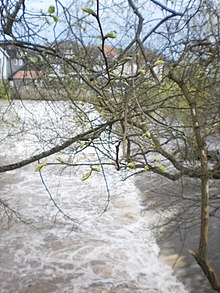Base ramp

The rock ramp (also Raue ramp , Eng. River bottom ramp ) is a hydraulic engineering term. Basically, it is about overcoming a height difference in the course of a body of water.
Instead of motion and potential energy of the upper water by a hydraulic jump in heat and sound convert, this takes place at the Rauheitselementen the ramp. In the event of high water , the ramp is completely flooded , the discharge capacity increases until the ramp is dammed by the underwater.
If a bed ramp is installed in a river, the passability for aquatic life forms and bed load is retained, and flood protection is achieved if properly dimensioned .
If an alternating jump is replaced by a base ramp, passabilities can be restored and existing flood protection can be retained.

Grüner Wehr in the Lahn
The bottom ramp is a steep section of the river (slope approx. 1: 3 to 1:10) with disruptive bodies in the form of stone deposits or stone fill . Here, stones or boulders up to about 1.2 m in diameter are placed or poured onto a multi-level gravel filter layer. There are numerous variants, from block stone insert to a modeled crash pool sequence. Depending on the design and the boundary conditions, bracing or post-bed securing is required to prevent the stones from being carried away and bottom erosion in the underwater.
Base ramps and the similarly designed base slides differ in their gradient: Base slides are more flat (1:20 to 1: 100) than base ramps (1: 3 to 1:10).
The bottom ramp is a natural alternative to classic weirs . The bottom ramp is intended to ensure an almost unhindered fish ascent, but also to limit deep erosion in the river bed.

However, the aim of unhindered fish ascent is only guaranteed by ramps and gliding at sufficiently low flow speeds and sufficiently high water depths with a large discharge spectrum. This can either only be achieved with significantly flatter ramps (1:40 to 1:50 and smaller) or with locking ramps or those with a sturgeon stone construction.
See also
Sources and literature
- ↑ Michael Hütte: Ecology and hydraulic engineering: ecological principles of water management and hydropower use. Vieweg, Wiesbaden 2000, ISBN 3528025832